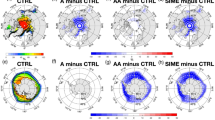Abstract
The modification of a relatively cold air mass over the warm water of Lake Michigan is studied by using a two-dimensional nonlinear mesoscale model. Considerable amounts of heat and water vapor are supplied from the water surface to the lower atmosphere by turbulent eddies. A convective mixed layer develops and grows toward the downwind region with stratocumulus clouds over the lake.
The model simulates the warming and moistening of the mixed layer, the development of a boundary layer, the divergence and convergence of wind near the coastlines, and the turbulent fluxes.
The model warming of the mixed layer across the lake was about 2.2 °K and the moistening of the mixed layer was about 0.8 g kg−1, which are comparable to 2.7 °K and 0.8 g kg−1 observed by Lenschow (1973). The convective boundary layer, which includes the cloud layer, subcloud layer, and superadiabatic layer near the water surface, is well simulated. The tilt of the inversion which coincides with the cloud top is also well reproduced. When a prescribed cooling rate is applied at the cloud top, stronger turbulence and a deeper cloud layer are generated. Without the cooling, the cloud is shallow and the shape of the cloud base is determined by surface conditions. The rise of the inversion is due to upward vertical motion, and deepening of the convective layer in the downwind region.
Similar content being viewed by others
References
Arakawa, A.: 1972, ‘Design of the UCLA General Circulation Model. Numerical Simulation of Weather and Climate’, Tech. Rept. 7, Dept. of Meteorology, Univ. of California, Los Angeles.
Asai, T. and Nakamura, K.: 1978, ‘A Numerical Experiment of Airmass Transformation Process over Warmer Sea. Part 1: Development of a Convectively Mixed Layer’, J. Meteorol. Soc. Japan 56, 424–434.
Brost, R. A.: 1976, ‘Air Mass Modification in the Atmosphere's Boundary Layers: A Study Using a Two Dimensional Numerical Model with a Higher Order Turbulence Closure’, Ph.D. dissertation, University of Wisconsin, Madison.
Businger, J. A., Wyngaard, J. C., Izumi, Y., and Bradley, E. F.: 1971, ‘Flux-profile Relationships in the Atmospheric Surface Layer’, J. Atmos. Sci. 28, 181–189.
Crowley, W. P.: 1968, ‘Numerical Advection Experiments’, Mon. Wea. Rev. 96, 1–11.
Deardorff, J. W.: 1976a, ‘On the Entrainment Rate of a Stratocumulus-topped Mixed Layer’, Quart. J. Roy. Meteorol. Soc. 102, 563–582.
Högström, A. S. and Högström, U.: 1978, ‘A Practical Method for Determining Wind Frequency Distributions for the Lowest 200 m from Routine Meteorological Data’, J. Appl. Meteorol. 17, 942–954.
Hsu, W. R.: 1986, ‘Numerical Simulations of Air Mass Modification over the East China Sea during the Winter Season’, Ph.D. dissertation, Purdue University, 124 pp.
Lenschow, D. H.: 1973, ‘Two Examples of Boundary Layer Modification over the Great Lakes’, J. Atmos. Sci. 30, 568.
Ninomiya, K. and Akiyama, T.: 1976, ‘Structure and Heat Budget of Mixed Layer Capped by Inversion during the Period of Polar Outbreak over Kuroshio Region’, J. Meteorol. Soc. Japan 54, 160–174.
Rokosz, S. G.: 1985, ‘Modification of Polar Air Masses over Lake Michigan’, M.S. Thesis, Purdue University, 216 pp.
Rothermal, J. R. and Agee, E. M.: 1980, ‘Aircraft Investigation of Mesoscale Cellular Convection During AMTEX 75’, J. Atmos. Sci. 37, 1027–1040.
Saito, N.: 1975, ‘A Synoptic Study of the Inversion during the AMTEX 74’, Papers in Meteor. and Geophysics 26, 121–147.
Stage, A. S. and Businger, J. A.: 1981, ‘A Model for Entrainment into a Cloud Topped Marine Boundary Layer. Part I: Model Description and Application to a Cold-air Outbreak Episode’, J. Atmos. Sci. 38, 2213–2229.
Sun, W. Y. and Ogura, Y.: 1979, ‘Boundary-Layer Forcing as a Possible Trigger to a Squall-Line Formation’, J. Atmos. Sci. 36, 235–254.
Sun, W. Y.: 1980, ‘A Forward-Backward Time Integration Scheme to Treat Internal Gravity Waves’, Mon. Wea. Rev. 108, 402–407.
Sun, W. Y.: 1984, ‘Numerical Analysis for Hydrostatic and Nonhydrostatic Equations of Inertial-Internal Gravity Waves’, Mon. Wea. Rev. 112, 259–268.
Sun, W. Y. and Hsu, W. R.: 1984, ‘Numerical Simulation of Atmospheric Mesoscale Convection’, Supercomputer Applications, Plenum Publishing Corporation, New York, USA, pp. 145–157.
Sun, W. Y. and Hsu, W. R.: 1988, ‘Numerical Study of a Cold Air Outbreak over the Ocean’, J. Atmos. Sci. 45, 1205–1227.
Yildirim, A.: 1987, ‘Numerical Simulation of Air Mass Modification over Lake Michigan’, M.S. Thesis, Purdue University, 59 pp.
Author information
Authors and Affiliations
Rights and permissions
About this article
Cite this article
Sun, WY., Yildirim, A. Air mass modification over Lake Michigan. Boundary-Layer Meteorol 48, 345–360 (1989). https://doi.org/10.1007/BF00123058
Accepted:
Issue Date:
DOI: https://doi.org/10.1007/BF00123058




